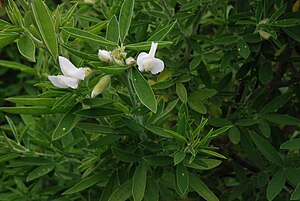Sprouting dwarf gorse
| Sprouting dwarf gorse | ||||||||||||
|---|---|---|---|---|---|---|---|---|---|---|---|---|

Sprouting dwarf gorse ( Chamaecytisus proliferus ) |
||||||||||||
| Systematics | ||||||||||||
|
||||||||||||
| Scientific name | ||||||||||||
| Chamaecytisus proliferus | ||||||||||||
| ( Lf ) Link |
The sprout end brooms ( Chamaecytisus proliferus ) is a plant type from the genus brooms ( Chamaecytisus ) and belongs to the family Leguminosae (Fabaceae).
description
The heavily branched shrub or the small tree reaches a height of between 50 and 500 centimeters, in rare cases up to 7 meters. The dark green leaves are tripartite and petiolate. The linear-lanceolate to obovate leaves can be pointed or blunt. The leaflets are densely hairy or glabrous.
The 16 to 25 mm large flowers are white, finally yellowish. There are 3 to 7 in the upper leaf axils. The flag is hairy on the outside. The röhrig to bell-shaped calyx is deep, two-lipped with five small teeth. The flowering period extends from January to June, but falls mainly in the months of March and April. The hairy legume is between 3 and 7.5 cm long. It is more or less curved and blackish when ripe.
The number of chromosomes is 2n = 46-50 or 52.
Occurrence
The sprouting dwarf gorse only grows in the Canary Islands , with the exception of Lanzarote and Fuerteventura . The species prefers locations in pine forests, but also in laurel forests . The sprouting dwarf gorse is also cultivated.
Systematics
This species is very rich in shape. 3 subspecies and 5 varieties have been described, which differ mainly in the shape of the leaflets, the size of the seeds and the hairiness of the flag.
- Chamaecytisus proliferus subsp. angustifolius
- Chamaecytisus proliferus subsp. meridionalis
-
Chamaecytisus proliferus subsp. proliferus
- Chamaecytisus proliferus subsp. proliferus var. proliferus
- Chamaecytisus proliferus subsp. proliferus var. canarieae
- Chamaecytisus proliferus subsp. proliferus var. calderae
- Chamaecytisus proliferus subsp. proliferus var. hierrense
- Chamaecytisus proliferus subsp. proliferus var. palmensis
use
This species is used intensively by the local population as a forage crop in cattle breeding. It is also used for the production of agricultural equipment and in charcoal burning.
literature
- Schönfelder: Kosmos Atlas Mediterranean and Canary Islands flora , Stuttgart 2002, ISBN 3-440-09361-1
- Hohenester / Welss: Excursion flora for the Canary Islands , Stuttgart 1993, ISBN 3-8001-3466-7
- Cabrera Pérez: The native flora of the Canary Islands , 1999, ISBN 84-241-3550-4
Individual evidence
- ^ Cytisus prolifer at Tropicos.org. In: IPCN Chromosome Reports . Missouri Botanical Garden, St. Louis
